Research on Monitoring Methods for Electrostatic Discharge Pulses in Spacecraft Dielectric Materials
Abstract
:1. Introduction
2. Simulation-Based Structural Design and VSWR Analysis of Monopole Antennas for Spacecraft ESD Monitoring
2.1. Principles and Structures of Monopole Antennas
2.2. Configuration and Modeling of Antenna Parameters
2.3. Simulation Results of VSWR
3. Design of Impedance Matching Circuit
4. Experimental Verification of Discharge Pulse Detection
4.1. Discharge Pulse Performance Testing of the Antenna
4.2. Simulation Experiments for Discharge Detection of Spacecraft Dielectric Materials
5. Conclusions
- (1)
- A sleeve monopole antenna tailored for monitoring the electrostatic discharge (ESD) processes in spacecraft dielectric materials was successfully designed. The antenna operates in the frequency range (28.73~31.25) MHz (VSWR < 2), with a center frequency of 30 MHz and a relative bandwidth of 8.4%.
- (2)
- The antenna’s VSWR performance improves with an increase in sleeve height (H), an increase in the inner conductor radius (R0), and a decrease in the insulation layer thickness (t) between the sleeve and the inner conductor. The feed point height (L) also impacts VSWR performance but is dependent on its interaction with other parameters. Among the three impedance matching circuits designed, the R-L series matching circuit demonstrated superior bandwidth characteristics, outperforming the other configurations.
- (3)
- Experimental verification showed that the antenna is capable of measuring pulse signals with electric field strengths in the ranges (−1000 to −80) V/m and (80 to 1000) V/m. With a measured center frequency of 25.47 MHz, the antenna reliably monitored discharge pulses generated by electron irradiation on spacecraft-grade FR4 dielectric materials, fulfilling the design requirements.
Author Contributions
Funding
Data Availability Statement
Conflicts of Interest
References
- Lu, Y.; Shao, Q.; Yue, H.; Yang, F. A review of the space environment effects on spacecraft in different orbits. IEEE Access 2019, 7, 93473–93488. [Google Scholar] [CrossRef]
- Hu, X.; Zhang, J.; Wei, M.; Wang, Y. Research on the Induced Electrostatic Discharge of Spacecraft Typical Dielectric Materials under the ESD Pulse Irradiation. Materials 2022, 15, 2115. [Google Scholar] [CrossRef]
- NASA-HDBK-4002B; NASA Handbook for Spacecraft Charging Mitigation. NASA: Washington, DC, USA, 2022. Available online: https://standards.nasa.gov/sites/default/files/standards/NASA/B/0/2022-06-07-NASA-HDBK-4002B-Approved.pdf (accessed on 15 October 2024).
- Engelhart, D.P.; Plis, E.A.; Ferguson, D.; Johnston, W.R.; Cooper, R.; Hoffmann, R.C. Space plasma interactions with spacecraft materials. In Plasma Science and Technology-Basic Fundamentals and Modern Applications; IntechOpen: London, UK, 2019; pp. 225–245. [Google Scholar]
- Dennison, J.R. Dynamic Interplay Between Spacecraft Charging, Space Environment Interactions, and Evolving Materials. IEEE Trans. Plasma Sci. 2015, 43, 2933–2940. [Google Scholar] [CrossRef]
- Fotis, G. Electromagnetic Fields Radiated by Electrostatic Discharges: A Review of the Available Approaches. Electronics 2023, 12, 2577. [Google Scholar] [CrossRef]
- Tan, Q.; Tang, J.; Zeng, F.P. Design of Fourfold-Band Micro-Strip Monopole Antenna for Partial Discharge Detection in Gas Insulated Switchgear. Trans. China Electrotech. Soc. 2016, 31, 129–135. [Google Scholar]
- Ishigami, S.; Kawamata, K.; Minegishi, S. Measurement of antenna gain for conical monopole antenna with double-Boltzmann tapered-line. In Proceedings of the 2023 Asia-Pacific Microwave Conference (APMC), Taipei, Taiwan, 5–8 December 2023. [Google Scholar] [CrossRef]
- Feng, C.Q.; Zhang, F.S. A Wideband Sleeve Monopole Antenna. In Proceedings of the 2018 Cross Strait Quad-Regional Radio Science and Wireless Technology Conference (CSQRWC), Xuzhou, China, 21–24 July 2018; pp. 1–2. [Google Scholar]
- Sun, A.G.; Crofton, M.W.; Young, J.A.; Cox, W.A.; Beiting, E.J. Time-domain radiated emissions measurement of laboratory simulated spacecraft on-orbit electrostatic discharge. In Proceedings of the 2014 International Symposium on Electromagnetic Compatibility, Gothenburg, Sweden, 1–4 September 2014; pp. 775–780. [Google Scholar]
- Shcherbyna, O.; Zadorozhniy, R. The log-periodic dipole array antenna for monitoring. In Proceedings of the 2018 14th International Conference on Advanced Trends in Radioelecrtronics, Telecommunications and Computer Engineering (TCSET), Lviv-Slavske, Ukraine, 20–24 February 2018. [Google Scholar] [CrossRef]
- Zhang, G.; Cui, Z.; Feng, N.; Tang, D.; Zhang, X. Centimeter-level 2D ultra-small interdigital sensor for ESD detection of spacecraft. Sens. Actuators A Phys. 2024, 377, 115648. [Google Scholar] [CrossRef]
- Mishra, P.K.; Rao, M.N.; Shastry, S.V.K.; Ghatpande, N.D.; Danabalan, T.L. Antenna for transient pulse monitor subsystem. In Proceedings of the 2006 9th International Conference on Electromagnetic Interference and Compatibility (INCEMIC 2006), Bangalore, India, 23–24 February 2006; pp. 482–485. [Google Scholar]
- Koons, H. Characteristics of electrical discharges on the P78-2 satellite/SCATHA. In Proceedings of the 18th Aerospace Sciences Meeting, Pasadena, CA, USA, 14–16 January 1980; p. 333. [Google Scholar]
- Kendre, M.; Nandgaonkar, A.B.; Nirmal, P.; Nalbalwar, S.L. U shaped multiband monopole antenna for spacecraft, WLAN and satellite communication application. In Proceedings of the 2016 IEEE International Conference on Recent Trends in Electronics, Information & Communication Technology (RTEICT), Bangalore, India, 20–21 May 2016; pp. 1528–1532. [Google Scholar] [CrossRef]
- Lu, J.H.; Cai, Y.S. Planar Compact Multi-Band C-Shape Monopole Antenna with Inverted L-Shape Parasitic Strip for Wimax Applications. Prog. Electromagn. Res. C 2011, 20, 17–29. [Google Scholar] [CrossRef]
- Ali Nezhad, S.M.; Hassani, H.R. A Novel Triband E-Shaped Printed Monopole Antenna for MIMO Application. IEEE Antennas Wirel. Propag. Lett. 2010, 9, 576–579. [Google Scholar] [CrossRef]
- Zaki, S.B.M.; Azami, M.H.; Yamauchi, T.; Kim, S.; Masui, H.; Cho, M. Design, analysis and testing of monopole antenna deployment mechanism for BIRDS-2 CubeSat applications. In Proceedings of the International Conference on Space Weather and Satellite Application (ICeSSAT 2018), Shah Alam, Selangor, Malaysia, 7–8 August 2018; Journal of Physics: Conference Series. IOP Publishing: Bristol, UK, 2019; Volume 1152, p. 012007. [Google Scholar] [CrossRef]
- Zhang, G.; Li, C.; Zhang, X.; Zhang, J.; Chen, L.; Liu, F. Optimized sleeve monopole antenna for detection of electrostatic discharge radiation of spacecraft solar array. Rev. Sci. Instrum. 2019, 90, 7881. [Google Scholar] [CrossRef]
- Vincenzo, I.; Emiliano, S.; Edmondo, S. An ESD test approach for spacecraft applications. In Proceedings of the 2016 International Symposium on Electromagnetic Compatibility-EMC EUROPE, Wroclaw, Poland, 5–9 September 2016; pp. 268–273. [Google Scholar]
- Yin, H.; Liu, H.; Qin, X.; Liu, Q.; Wang, J.; Wen, X.; Wang, P.; Yu, Z.; Yang, S. Research on High-Precision and Wide-Range Spacecraft Potential Measurement Method Based on Capacitive Voltage Division. Sensors 2024, 24, 7583. [Google Scholar] [CrossRef] [PubMed]
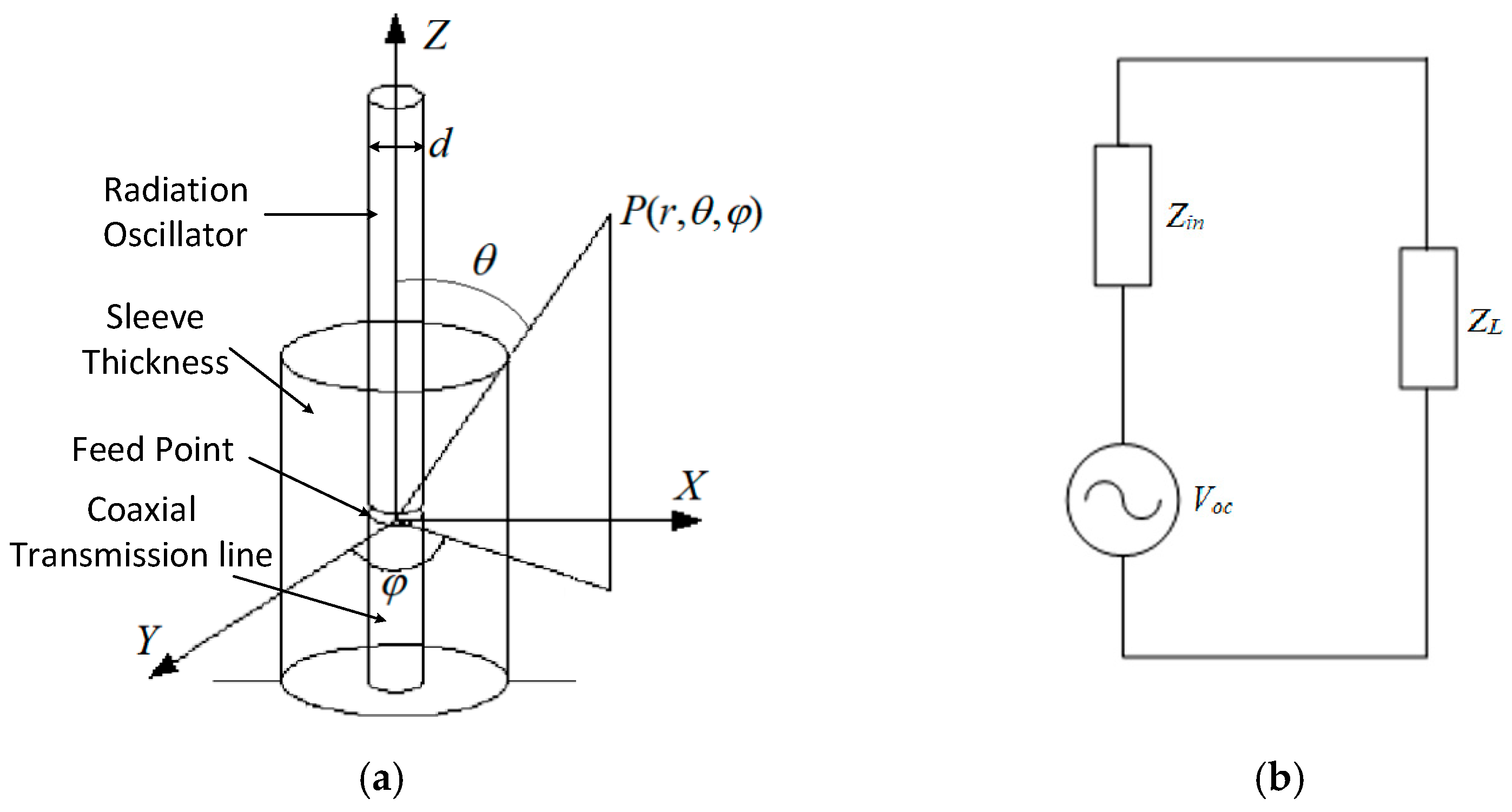
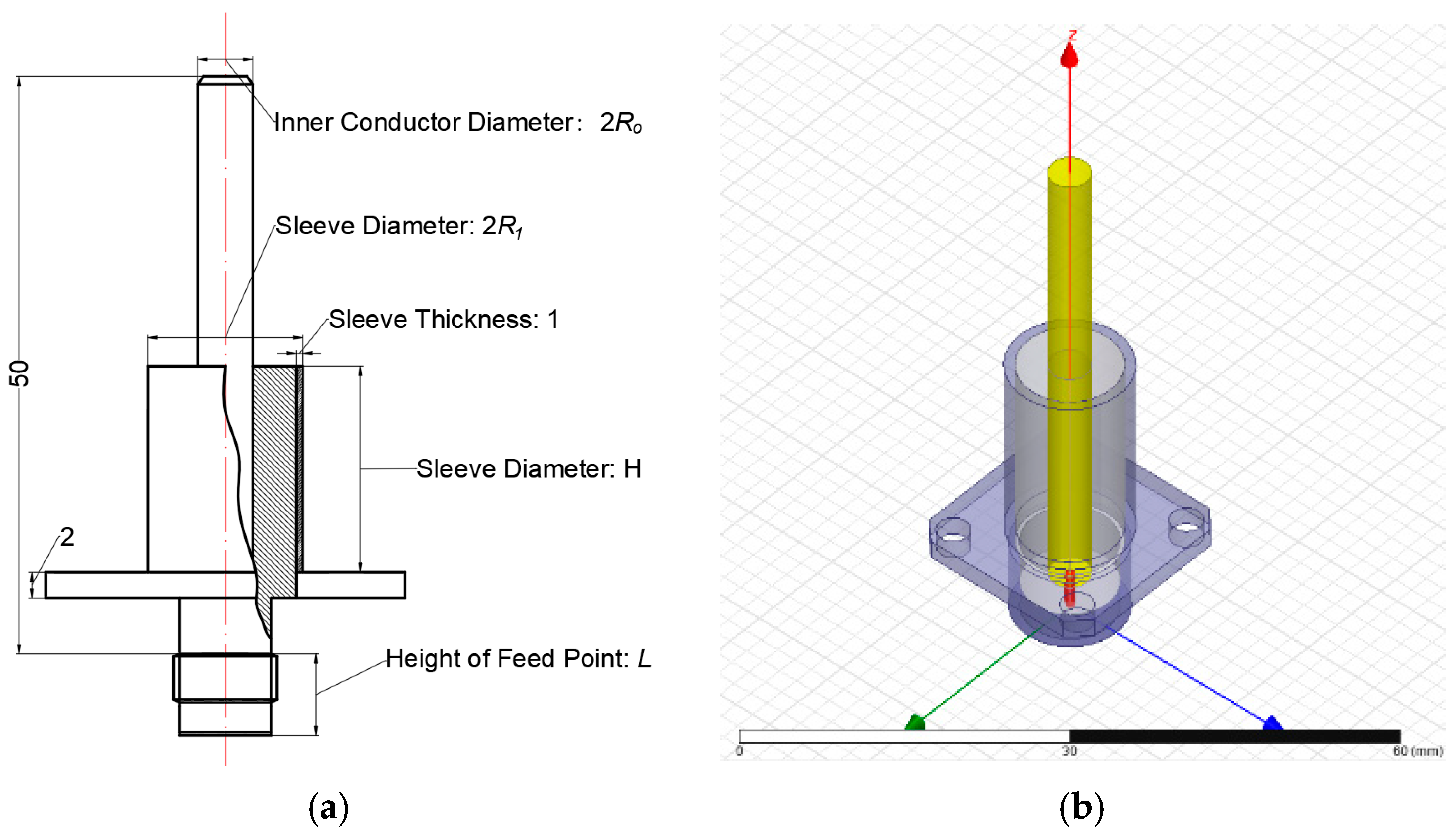








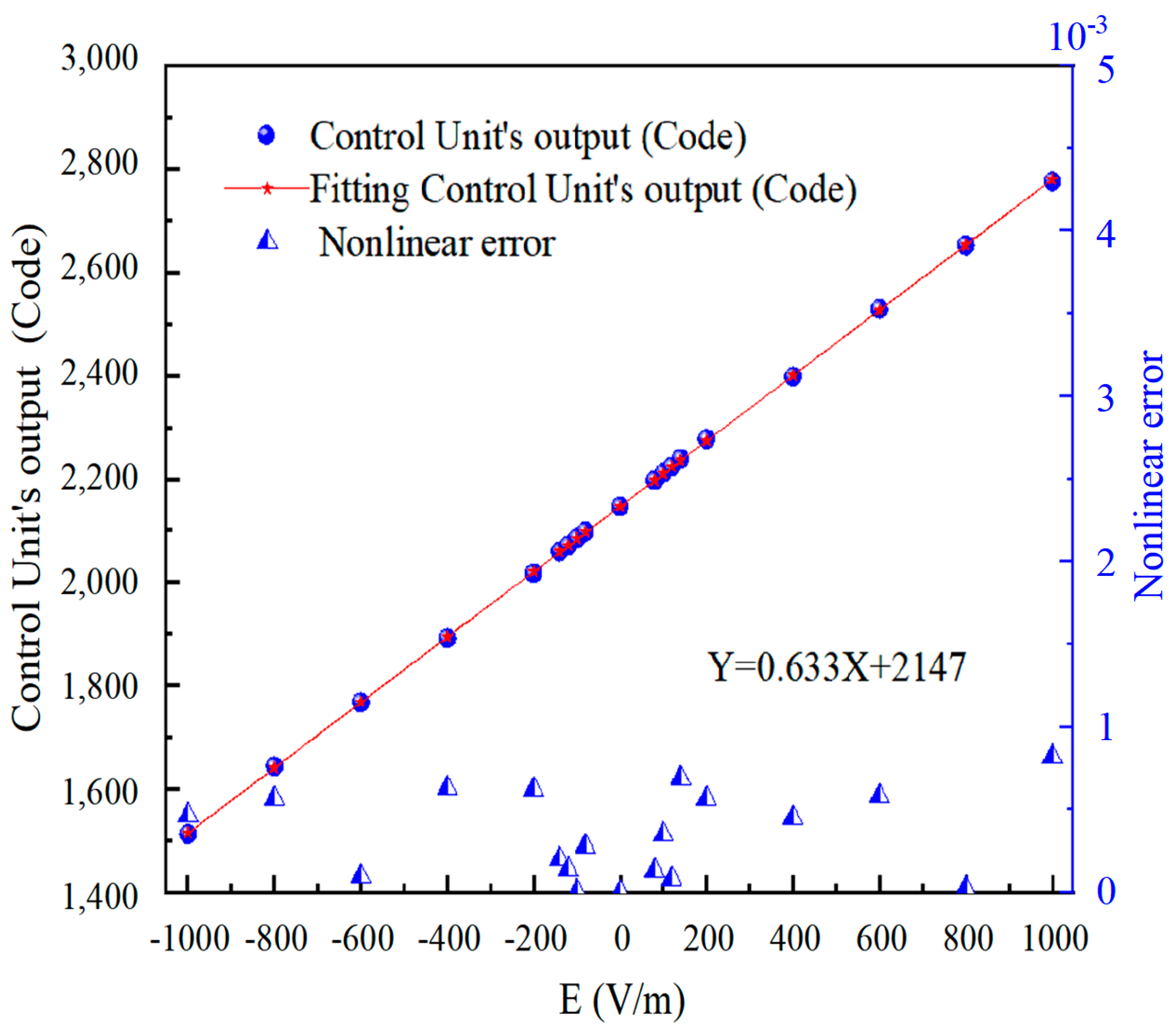
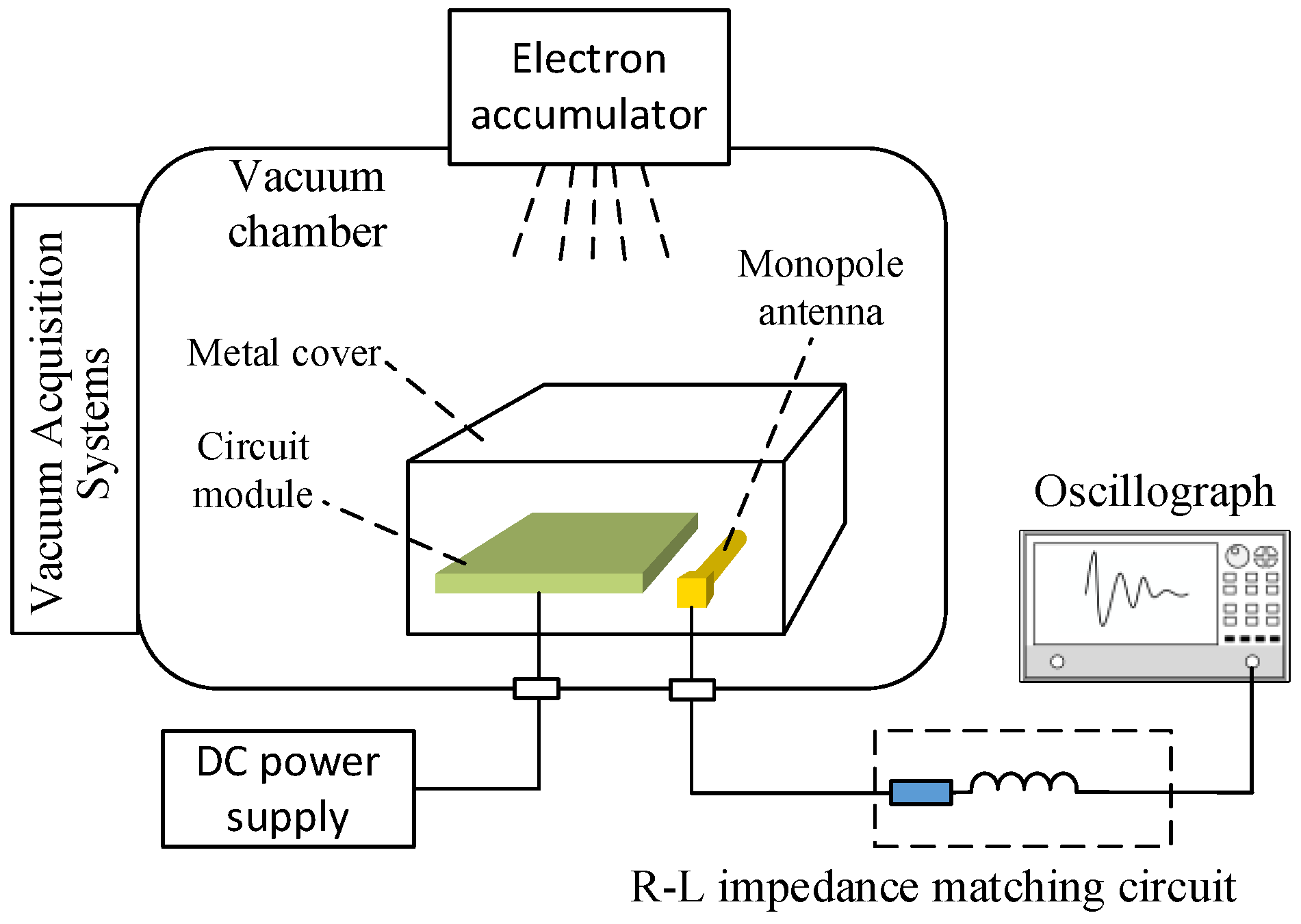
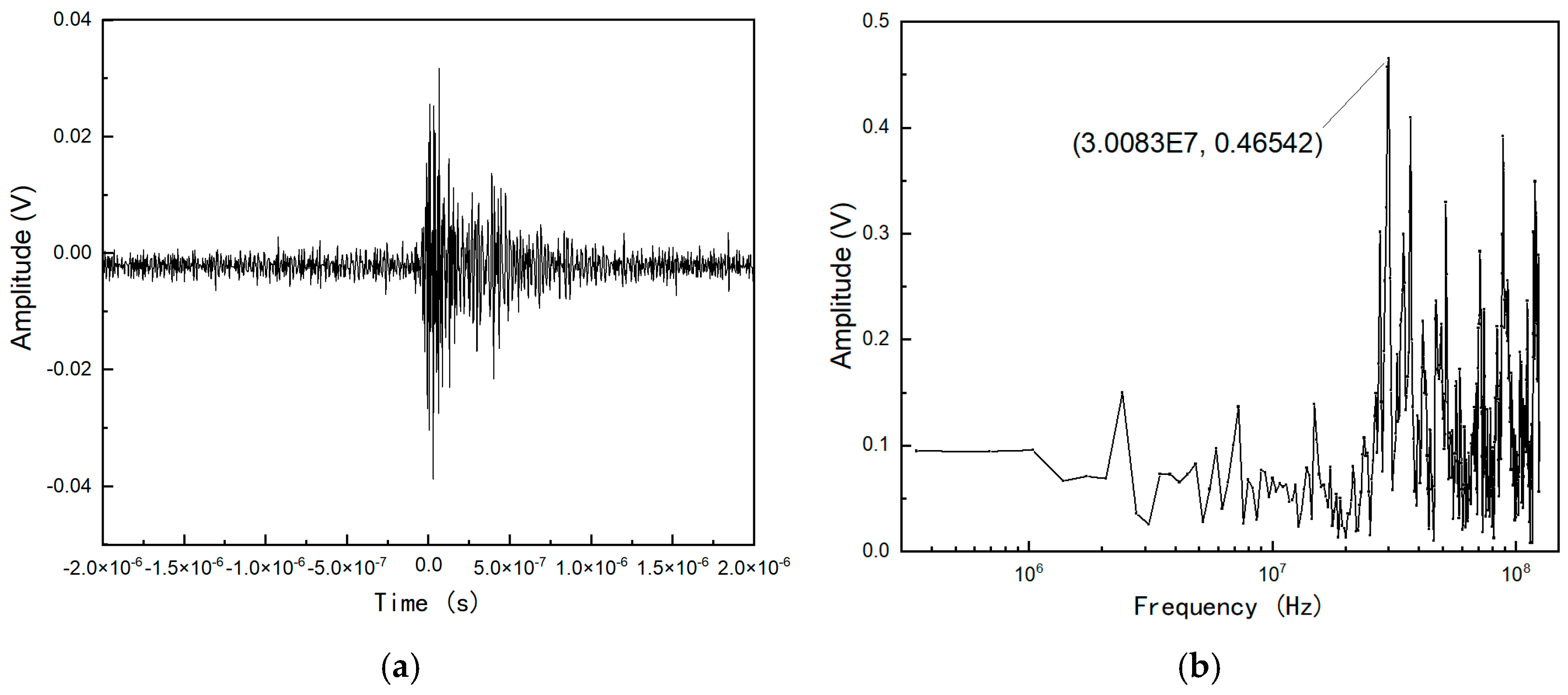
| Matching Network Type | C (pF) | L (µH) | R (Ω) | Bandwidth Characterization (MHz) (VSWR < 2) | Relative Bandwidth |
|---|---|---|---|---|---|
| C-L Low-pass | 884 | 4.6 | / | 29.96–30.03 | 0.23% |
| C-L High-Pass | 0.733 | 4.1 | / | 29.98–30.02 | 0.13% |
| R-L Series | / | 4.7 | 50 | 28.73–31.25 | 8.4% |
| Beam Density (pA/cm2) | Time (min) | Number of Discharges (Times) |
|---|---|---|
| 0.16 | 0~30 | 1 |
| 30~90 | 2 | |
| 90~180 | 4 | |
| 0.81 | 0~30 | 1 |
| 30~90 | 3 | |
| 90~180 | 5 | |
| 4.2 | 0~30 | 2 |
| 30~90 | 4 | |
| 90~180 | 7 | |
| 19 | 0~30 | 2 |
| 30~90 | 6 | |
| 90~180 | 9 | |
| 32 | 0~30 | 3 |
| 30~90 | 7 | |
| 90~180 | 11 |
Disclaimer/Publisher’s Note: The statements, opinions and data contained in all publications are solely those of the individual author(s) and contributor(s) and not of MDPI and/or the editor(s). MDPI and/or the editor(s) disclaim responsibility for any injury to people or property resulting from any ideas, methods, instructions or products referred to in the content. |
© 2025 by the authors. Licensee MDPI, Basel, Switzerland. This article is an open access article distributed under the terms and conditions of the Creative Commons Attribution (CC BY) license (https://creativecommons.org/licenses/by/4.0/).
Share and Cite
Yin, H.; Li, C.; Zhao, C.; Qin, X.; Lu, X.; Wen, X.; Shi, L.; Liu, Q.; Wang, J.; Jia, H.; et al. Research on Monitoring Methods for Electrostatic Discharge Pulses in Spacecraft Dielectric Materials. Micromachines 2025, 16, 180. https://doi.org/10.3390/mi16020180
Yin H, Li C, Zhao C, Qin X, Lu X, Wen X, Shi L, Liu Q, Wang J, Jia H, et al. Research on Monitoring Methods for Electrostatic Discharge Pulses in Spacecraft Dielectric Materials. Micromachines. 2025; 16(2):180. https://doi.org/10.3390/mi16020180
Chicago/Turabian StyleYin, Hong, Cunhui Li, Chengxuan Zhao, Xiaogang Qin, Xiaojin Lu, Xuan Wen, Liang Shi, Qing Liu, Jun Wang, Hanwu Jia, and et al. 2025. "Research on Monitoring Methods for Electrostatic Discharge Pulses in Spacecraft Dielectric Materials" Micromachines 16, no. 2: 180. https://doi.org/10.3390/mi16020180
APA StyleYin, H., Li, C., Zhao, C., Qin, X., Lu, X., Wen, X., Shi, L., Liu, Q., Wang, J., Jia, H., & Yang, S. (2025). Research on Monitoring Methods for Electrostatic Discharge Pulses in Spacecraft Dielectric Materials. Micromachines, 16(2), 180. https://doi.org/10.3390/mi16020180






